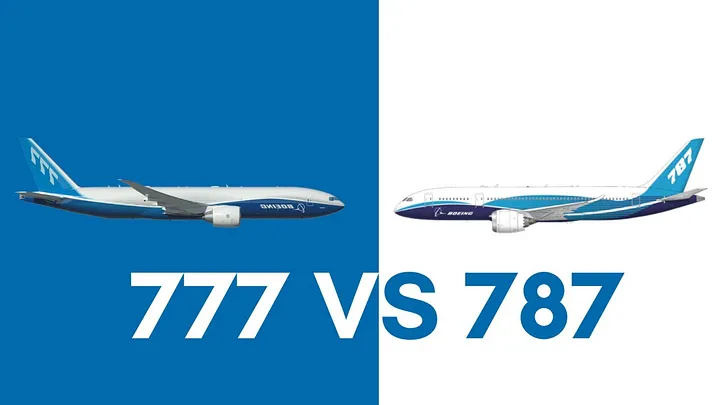When it comes to selecting between the Boeing 777 vs 787, airlines must carefully evaluate their specific needs as both planes offer distinct advantages and disadvantages. The competition between Boeing 787 vs 777 remains in the commercial aviation industry as both are widely being used in the market. If an airline requires an aircraft with greater cargo or seat capacity, the Boeing 777 is likely the better choice. However, if an airline is seeking a more cost-effective or financially feasible option for long-haul flights, the Boeing 787 would be its choice.
Boeing 777 Long-Range Wide Body Airliner
Boeing Commercial Airplanes designed and manufactured the Boeing 777, a twin-engine jet airliner with a wide-body and long-range capability. Its development commenced in the early 1990s and the plane made its inaugural flight in June 1994.
Boeing 777 – A look back
Here is a brief history of the Boeing 777
In the early 1990s, Boeing identified a need for a new long-range wide-body airliner to compete with the Airbus A340 and McDonnell Douglas MD-11. In October 1990, Boeing launched the development of the 777 with an order from United Airlines for 34 aircraft. The 777 was designed to be the first fly-by-wire commercial aircraft. Meaning that the pilot’s commands are transmitted electronically rather than through mechanical linkages.
The first 777 prototype was rolled out in April 1994, and its maiden flight took place on June 12, 1994. The 777 was well-received by airlines and passengers for its fuel efficiency, range, and passenger comfort. Over the years, Boeing has introduced several variants of the 777, including the 777-200ER (extended range), 777-300, 777-200LR (long range), and 777-300ER. As of September 2021, over 1,700 777s have been delivered to airlines around the world, making it one of the most successful wide-body aircraft in history.
Roll out purpose for B777
The “triple seven,” is one of the favorite commercial aircraft by both parties such as airlines and pilots. The 777 is often used on long-haul international routes, where its fuel efficiency, range, and large capacity make it an ideal choice.
| Technical specification | 777-200LR | 777-300ER |
| Seats (2-class) | 317 | 396 |
| Range (km) | 15,843 km | 13,649 km |
| Length | 63.7 m | 73.9 m |
| Wingspan | 64.8 m | 64.8 m |
| Height | 18.6 m | 18.5 m |
Popular B777 – Competition
The Boeing 777 has several competitors in the wide-body twin-engine commercial airliner market. Some of its main competitors are
- Airbus A350 XWB: Airbus produces the A350 XWB, which competes directly with the Boeing 777 in the market.
- Boeing 787 Dreamliner: The 787 Dreamliner is another Boeing aircraft because of its fuel efficiency and range of 7,355 it competes directly with the 777.
- Airbus A330neo: The Airbus A330 has been enhanced and is a competitor to the Boeing 777 in the market. This aircraft is known for its fuel efficiency and can cover a range of 7,200 nm.
- Airbus A380: with a range of 8000nm, is a larger aircraft than the 777. It competes with the 777 on some routes where passenger demand is high.
Order and Deliveries
Boeing had received a total of 2,104 orders for the 777 from airlines and leasing companies, with 1,669 delivered. The 777 is available in several variants, including the 777-200, 777-200ER, 777-300, 777-300ER, and 777F.
Some of the major customers for the Boeing 777 include Emirates, Singapore Airlines, Cathay Pacific, United Airlines, and Delta Air Lines. Boeing has also launched a new variant of the 777, called the 777X. As the B777-300er and B777-200lr gain their popularity from range, Boeing is taking another step by introducing the 777x. The 777X features new engines and wings, along with technological improvements in design. To increase efficiency and reduce operating costs for airlines. The 777x is scheduled to enter service in the future.
Related: Boeing 737 MAX VS Airbus A320neo Which Aircraft Is the Best?
Boeing 787 Dreamliner – Overview
The Boeing 787, also referred to as the Dreamliner, is a well-liked passenger jet produced by Boeing Commercial Airplanes. It is a twin-engine, long-range jet airliner with a wide body that can carry both passengers and freight.
History of Boeing 787
The construction of the aircraft commenced in June 2006 and was finalized in May 2007. The first aircraft was launched in July 2007, and the first voyage of the Boeing 787 Dreamliner took off from Paine Field in Everett, Washington on December 15, 2009.
B787- Purpose
The need to create aircraft with higher fuel consumption led to the creation of the 787. With a carrying capacity of 200 to 300 passengers, Boeing intended to be 20% less fuel efficient than the aircraft to replace the 787, such as the 767 and 777, to be used primarily on point-to-point routes up to (15,700 km). The 787 is the first commercial airplane that primarily utilizes composite materials in its structure. With a cockpit that has four windows and angular wing tips, it has a unique and recognizable look.
B787 by design
By design B787 is popular for several reasons:
- Fuel Efficiency: The 787 uses advanced materials and aerodynamic design, making it up to 20% more fuel-efficient than similar-sized aircraft. This means lower operating costs for airlines and a reduced environmental impact.
- Comfort: The 787 has larger windows that dim electronically, a quieter cabin, and a lower cabin altitude, which reduces the effects of jet lag on passengers. Additionally, the cabin is pressurized to a lower altitude, which helps passengers feel more comfortable during long flights.
- Range: The 787 has an impressive range, allowing it to fly non-stop for up to 8,000 nautical miles. This makes it well-suited for long-haul flights and opens up new routes that were not previously possible.
- Technology: The 787 features advanced technology, including a composite fuselage, fly-by-wire flight controls, and an advanced electrical system. These innovations make aircraft more efficient and reliable.
| Technical specification | 787-10 Dreamliner |
| Passengers (two-class) | 336 |
| Range (km) | 11,730 km |
| Length | 68 m |
| Wingspan | 60 m |
| Height | 17 m |
| Engine | GEnx-1B |
| Max T/O Weight | 553000 Lb |
| Fuel Capacity: | 33384 gal Lb |
| Service Ceiling | 43000 ft |
Popular B787 – Competition
The Airbus A350 XWB is its rival in the market for long-haul, wide-body aircraft. Both the Boeing 787 and the Airbus A350 XWB are well-liked options for airlines seeking modern, fuel-efficient planes that can travel great distances. The Boeing 777X and the Airbus A330neo are additional rivals in this industry.
Order and Deliveries
By the end of December 2022, the 787 program had received 1,608 orders and delivered 1,037 aircraft.
conclusion
Comparing the used Boeing 787 vs 777 aircraft, the former often attracts buyers seeking fuel-efficient, modern technology with composite materials. In contrast, the Boeing 777 models are favored for their larger passenger capacity and longer range, making them suitable choices for airlines operating high-density, long-haul routes. Both options offer distinct advantages, depending on an airline’s specific operational requirements and market demand.






Leave a Reply